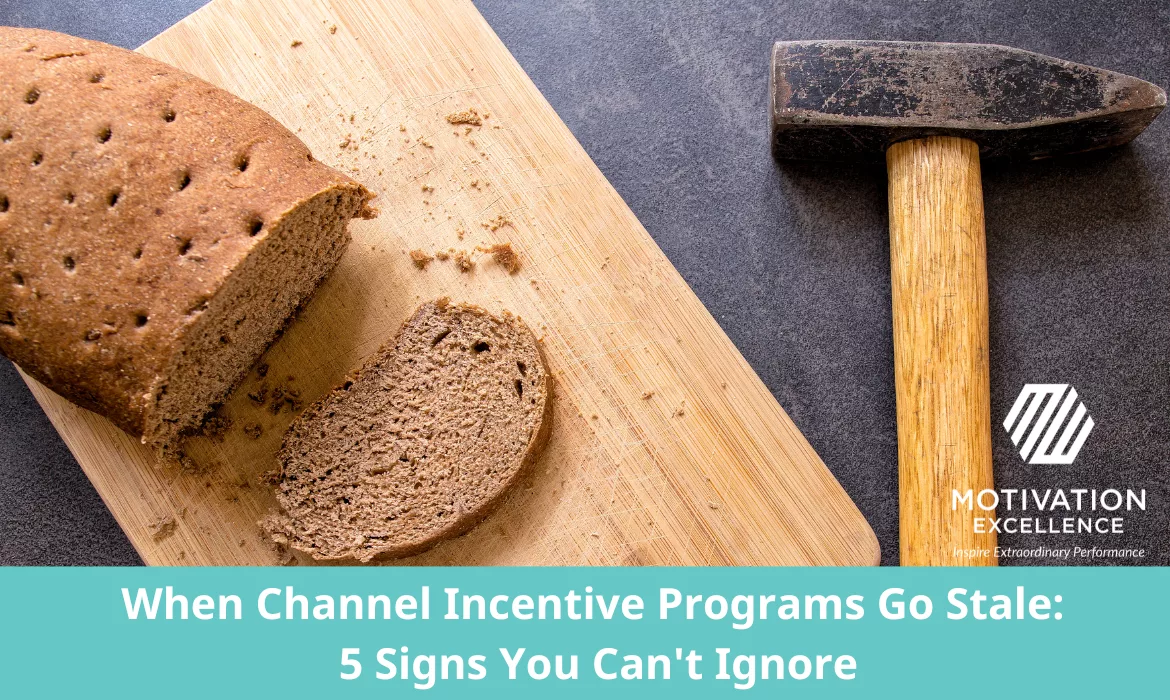
By Brian McHugh
As channel leaders prepare 2026 growth strategies amid economic headwinds, there is a dangerous tendency to maintain the status quo with channel programs that appear to be “working fine.” The reality is different. In today’s competitive landscape, “fine” is the enemy of growth, ROI and performance improvement. Programs that lose their edge don’t just stall, they drain budget, underperform, and invite competitors in.
At Motivation Excellence we have worked with manufacturers and distributors for 40 years to design, motivate and execute channel incentive programs. We know it’s easy for programs to slip into mediocrity. The warning signs start subtly, then compound quickly, turning your potential growth driver into a costly obligation.
Here are five critical signs that your channel incentive program needs attention now.
Your Sales Team Has Gone Silent
Healthy programs generate conversation. Your sales team should be the tip of the spear when it comes to communicating with your customers. They should understand the program, advocate for it, sell it, and help prove its value. Ultimately, a program is a tool designed to grow sales, and that tool should have your sales team’s fingerprints all over it.
When your sales organization stops providing feedback about what is working or not working in the program, or when program discussions disappear from your meetings and you stop promoting it, it signals a loss of confidence in the value proposition. Suddenly your investment becomes an expense.
When salespeople stop talking about it, partners stop hearing about it. Enrollment slows. The program fades from view. If you have not heard your sales team discuss the program recently, it’s time to ask why.
Your Provider Operates in “Set and Forget” Mode
Think of every incentive program as two engines: one powers how it runs (rules, platforms and rewards), the other powers where it’s going (strategy, outcomes, insights, scale). When the second engine stalls, so does growth.
When management of the program becomes vendor-like instead of a personalized strategic advisor, you may notice the provider’s business reviews start to become status updates. Reviews happen infrequently or devolve into just data dumps. The provider rarely suggests proactive enhancements and seems unfamiliar with your industry challenges. They treat your program as software rather than a strategic growth tool.
An incentive program is not just software, rewards, or travel experiences; it is a vehicle for executing business strategy. Your provider should understand channel dynamics, competitive pressures, and growth objectives. They should deliver insights, analytics, and recommendations that keep you ahead of trends.
Successful programs require continuous improvement. We’ve seen firsthand how a more hands-on, insight-driven approach can turn around stagnant performance, like this flooring company case study where program participation rebounded after a strategic reset. If your provider is not bringing ideas, you may have a vendor problem as much as a program problem.
Catalog Fatigue, Recycled Destinations
When redemptions start to repeat for the same item and trips feel predictable, your program is losing its pull. Participants begin to view online reward items as ordinary. Comments like, “I can get this cheaper on Amazon,” or, “Where are we going this time?” shift from excited to indifferent.
When redemptions stop being celebrated or even mentioned it means the program is no longer creating moments worth talking about.
This is critical because aspiration, not just costs, drives engagement. Participants crave rewards that feel earned and meaningful, not transactional handouts. Loyalty is an emotion not a transaction. When rewards feel like something anyone could buy anytime, the sense of accomplishment fades. Activity may still be tracked, but the deeper motivation dims and engagement wanes. Rewards have power when they become personal, not just part of their income.
Reward Entitlement and Compensation Creep Take Hold
Every incentive program exists on a spectrum, from a motivator where awards feel like earned recognition, to compensation, where they feel like expected income. The slide toward compensation happens gradually and poses serious risks.
Warning signs emerge when participants start requesting rewards like cash, rebates, or gift cards instead of traditional rewards. Exceptions for cash equivalents like one-off payments, rebates, or credits begin to multiply. You might notice some push back on any program changes, especially from top earners. Gaming behaviors surface, participants try to time submissions strategically to maximize claim payouts.
This shift marks dangerous territory. Once awards feel like entitlements, participants mentally categorize them alongside salary and benefits. What once motivated performance now simply maintains the status quo. The emotional connection between effort and reward has dissolved.
Channel leaders or program managers might be saying: “Are we paying for business we’d achieve regardless?” When programs drift into compensatory territory, the answer is usually yes. Cash has its place but when it becomes the default, your program becomes payroll with extra steps.
Your Program Rewards the Same Performance Patterns Year After Year
Whether it is travel qualifiers, SPIFF winners, or points-based awards, the same partners consistently achieve top rewards while most of the channel sits in lower tiers or disengages. Additional promotions stop. Earning opportunities feel thinner for the participant. Engagement starts to fade.
When invoices arrive and you think “this feels like a cost of doing business,” or you might think the program has become “too rich,” that usually signals something deeper. Rule structures and earning logic have not evolved. Rules that felt innovative at launch now feel predictable.
The risk here falls on program managers. If you continue to ask your channel for more volume, new product sales, and market expansion, year after year without refreshing the program, fatigue will follow.
Bottom line: If you ask partners to do more while the program stays the same, do not expect the same or greater loyalty in return.
The Path Forward
These warning signs rarely appear all at once. They build quietly over time. Performance softens, engagement slips, and what was once a growth engine starts to feel like a sunk cost.
The most effective channel programs never stand still. They evolve with the market. Communications are constantly refreshed. Earning structures are recalibrated. Rewards stay aspirational. Promotions feel timely and relevant. Nothing runs on autopilot.
Now is the time to ask the hard questions. Is your incentive program still delivering measurable value, or has it become an expensive obligation? Your 2026 growth goals will not be met by programs that simply maintain the status quo. They will be met by programs that inspire action, capture mindshare, and earn loyalty.
At Motivation Excellence, we partner with channel leaders to uncover what is working, what is not, and what needs to change. If any of these signs sound familiar, schedule a complimentary program evaluation. We will help you assess your current structure and identify clear steps to reignite engagement and drive growth.


